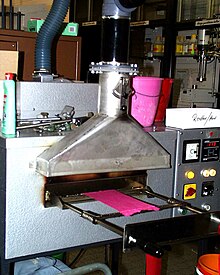Stenter frame
A tenter frame is a textile machine in the field of textile finishing for the heat treatment of fabrics (textiles) and knitted fabrics in wide form.
function
Tenter frames not only dry textiles, they also give the goods their final width by tensioning and fixing them with hot air. They can be used to influence the weight per unit area through the interplay of tension and lead. By installing straightening devices, distortions are corrected.
Procedure
The textile material is driven through the so-called fields of the tenter frame, where heated air flows over or through it. A tenter frame has i. d. Typically 6 to 10 fields that are generally 3 m long. Different temperatures can be set within the fields. The textile material can not only be dried in a stenter, but also heat-treated to fix dye. Drying processes require a lower temperature than fixations.
The transport mechanism of the textile through the tenter frame is carried out with chains on both sides of the tenter frame. The textile web is attached to these chains with needles or clips. Tenter frames can also be used as a unit in textile coating for elastic textiles.
heater
Tenter frames can be heated with:
- direct gas heating
- indirect gas heating
- Thermal oil heating
- indirect steam heating
- electric heating
- combined systems
The most common are indirect gas and thermal oil heating.
Combination with other machines
A foulard for the application of chemical preparations or dyes or for mechanical dewatering with the aim of reducing the drying time in the tenter and thus energy consumption is often upstream of a stenter . In addition, heat recovery systems are often installed to heat the fresh air supplied in order to save energy.

